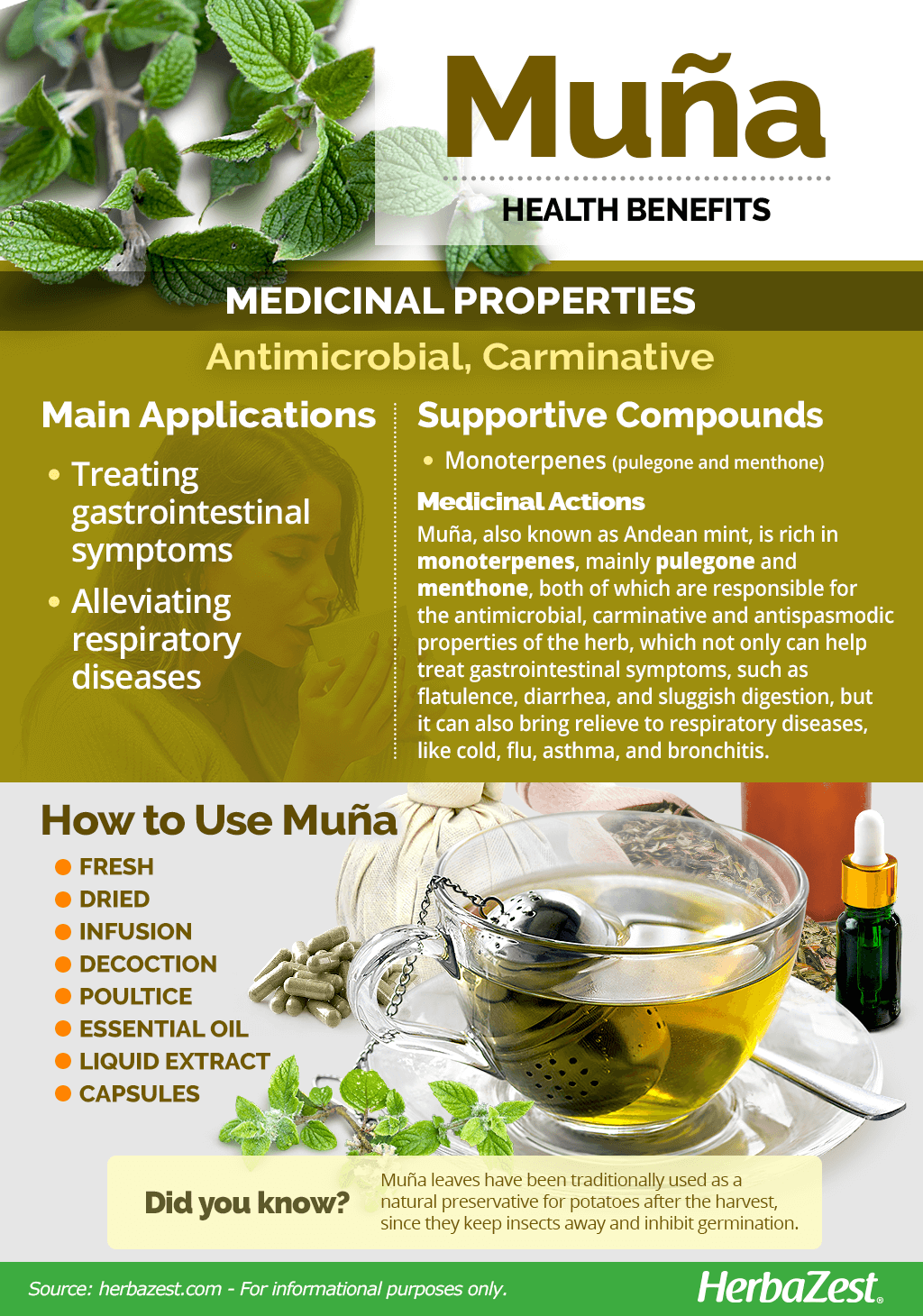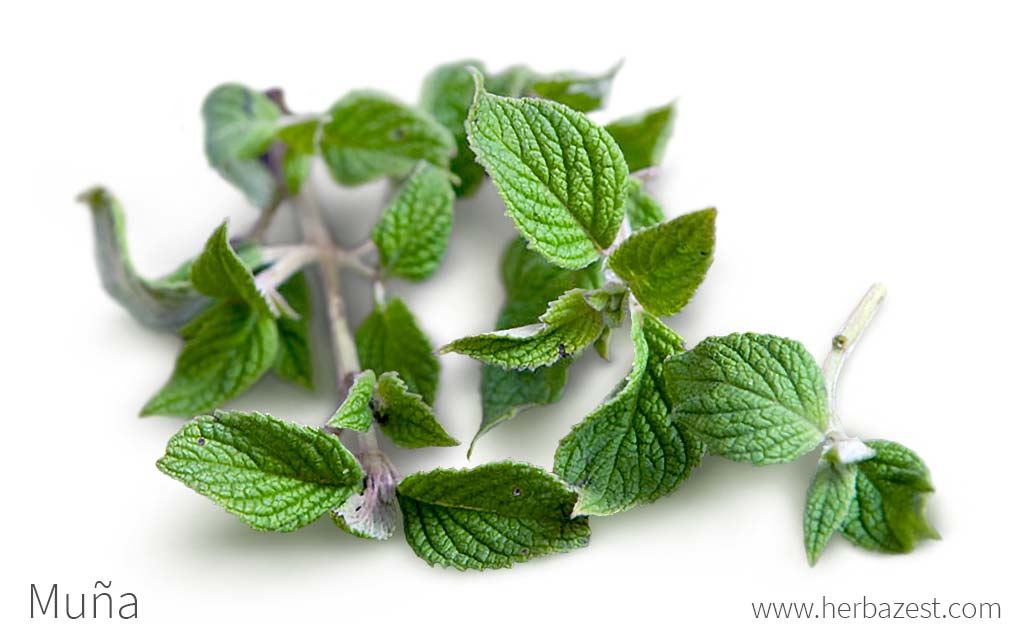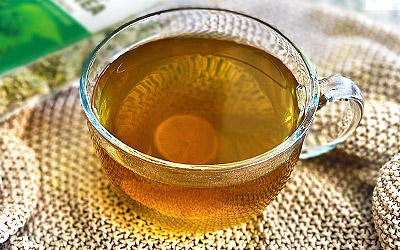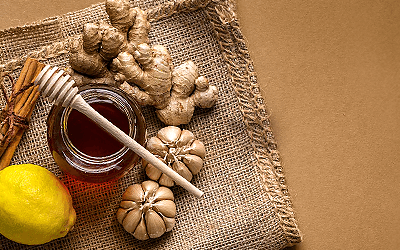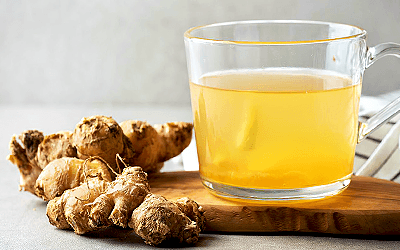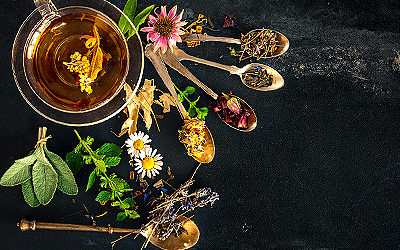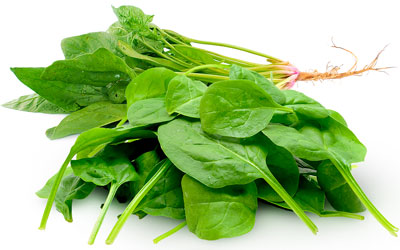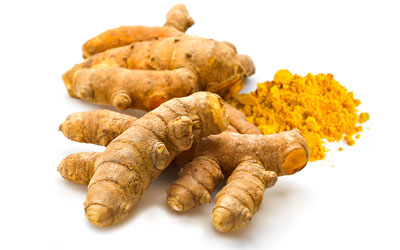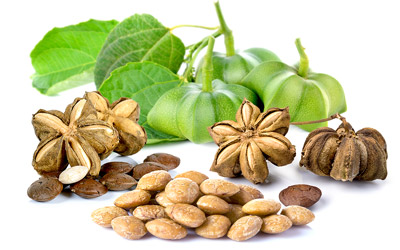Native to South America, the muña herb, also known as Andean mint, muna, and munya, grows naturally across Andean regions and is highly valued for its medicinal properties. From alleviating stomach discomfort to treating respiratory diseases, muña has found many popular applications, some of which have been studied and validated by modern science.
Muña Medicinal Properties
Benefits of Muña
Muña has been historically used in a medicinal capacity by local communities across South America. Its antimicrobial and digestive properties have led to a variety of applications, some of which have been validated by modern science. The most remarkable muña's benefits are:
Treating gastrointestinal symptoms. The muña plant has been traditionally used to treat digestive disorders, such as indigestion, stomachache, diarrhea, and colic.
Alleviating respiratory diseases. Due to its anti-inflammatory, antispasmodic, and antimicrobial properties, muña is popularly used to relieve cough, headache, cold, flu, asthma, and bronchitis.
Other traditional uses of muña include eliminating parasites, flea infestations, and fungal infections as well as calming muscle spasms.
How It Works
The most important active compounds in muña are monoterpenes, which have been suggested to be responsible for the main benefits of this Andean herb. Two monoterpenes stand out for their high concentrations: pulegone and menthone, both of which have been shown effective against gram-positive and gram-negative bacteria.1,2
These compounds are not only antimicrobial and antifungal but also have strong antioxidant, anti-inflammatory, antispasmodic, and digestive properties. While muña's mechanisms of action are still under study, pulegone has been shown to influence the nervous system, inhibiting the detection of irritating, painful stimuli, which may explain its efficacy in relieving respiratory problems and gastrointestinal discomfort.3
On the other hand, menthone not only has strong antibacterial effects but also anti-inflammatory properties that bring relief to the symptoms of respiratory diseases.4
Other herbs that are commonly used for treating respiratory problems are eucalyptus, thyme, coltsfoot, and myrtle, whereas cardamom, dill, marjoram, and peppermint are well-known for their digestive, carminative effects.
Side Effects & Cautions
In medicinal doses, muña is generally safe; however, excessive intake can cause liver toxicity. Since further studies are needed to determine the safety of muña during pregnancy and lactation, women going through these stages should avoid consumption.
- Medicinal action Antimicrobial, Carminative
- Key constituents monoterpenes (pulegone and menthone)
- Ways to use Capsules, Hot infusions/tisanes, Liquid extracts, Tincture, Poultice, Essential oil, Dried
- Medicinal rating (3) Reasonably useful plant
- Safety ranking Safe
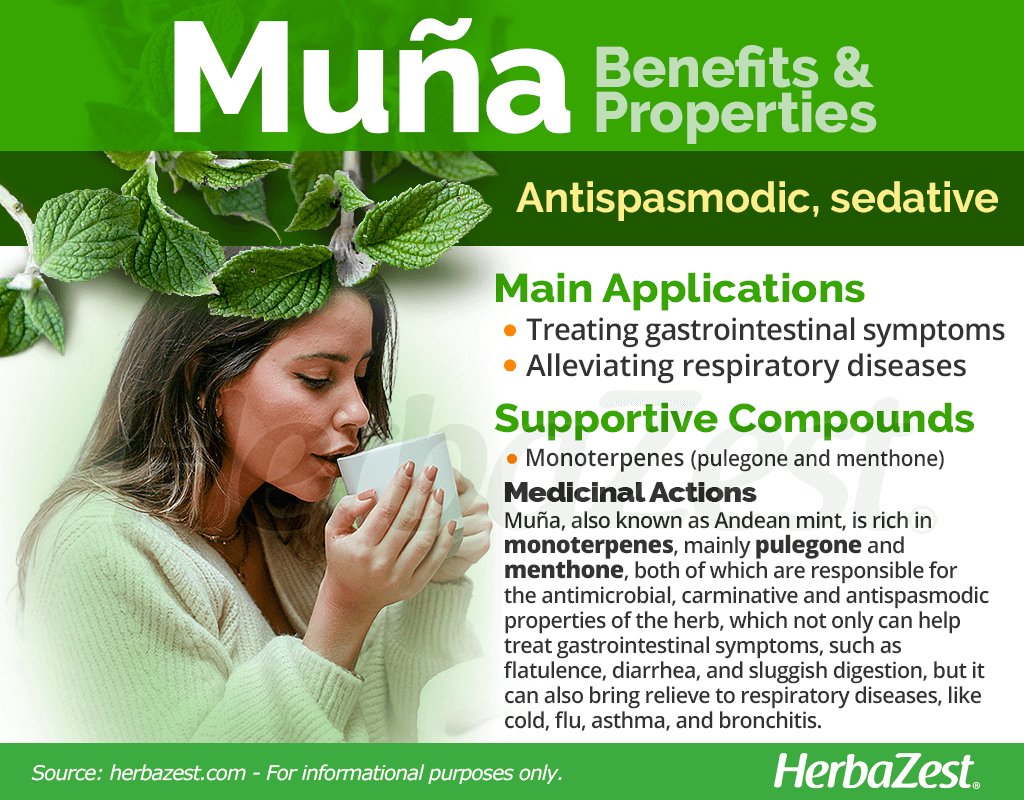
How to Consume Muña
Since ancient times, the muña plant has been used in some culinary capacity to flavor soups and stews, but mostly as a healing herb.
Natural Forms
Fresh. In high-altitude Andean communities, where the plant naturally grows, muña is often consumed fresh, in culinary and medicinal ways.
Dried. This is the most popular way to preserve muña and obtain its benefits in different preparations.
Infusion. Muña tea is taken to extract the medicinal properties of the herb in order to alleviate stomachache, cough, diarrhea, indigestion, asthma, and many other health conditions.
Decoction. A decoction requires the leaves to be boiled in water for a bit more time than an infusion, in order to concentrate muña's healing properties.
Poultice. Due to its antimicrobial and antiseptic properties, a warm poultice of muña leaves is used to disinfect superficial wounds and for treating and preventing infections.
Herbal Remedies & Supplements
Essential oil. A few drops of muña essential oil, diluted in a glass of water, can be enough to reap the antimicrobial, antispasmodic, and carminative properties of the herb.
Liquid extract. Extracts of muña concentrate the health benefits of the herb and can be consumed diluted in water as an alternative treatment for colic, indigestion, and common respiratory problems.
Capsules. Widely available, muña capsules contain the pulverized leaves of the Andean herb in practical, easy-to-take standardized doses.
- Edible parts Leaves
- Taste Aromatic
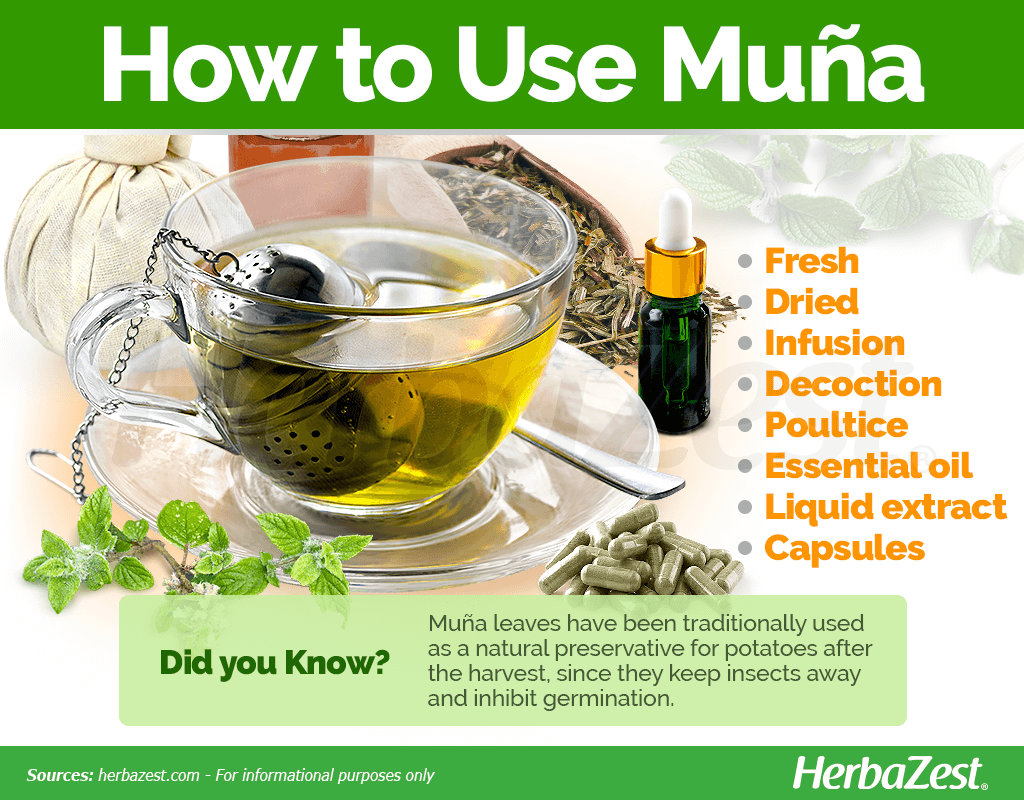
Growing
The muña plant is a perennial woody shrub that grows exclusively in the arid highlands of the Andes, with temperate to cold temperate climates, and it needs very specific conditions to thrive.
Muña Growing Guidelines
The muña plant grows better in loamy-sandy-stony soils, with a lifespan of up to 20 years; however, in clay-loamy soils, it can reach a lifespan of 10 years. It does not tolerate saline soils.
This herbaceous shrub is highly tolerant of low temperatures; however, cold burns can appear in the aerial parts below 23°F (-5°C).
The rainy season is the best time to cultivate muña in the Andes, between November and March.
- Life cycle Perennial
- Harvested parts Leaves
- Light requirements Full sun
- Soil Loamy sand, Silt loam, Clay loam, Silty
- Growing habitat Cool temperate regions, Andean region
- Planting time Fall
Additional Information
Taxonomy of Muña
Muña, also known as Andean mint, is a perennial woody shrub that naturally grows on rocky, stony slopes, 8,350 to 12,467 feet (2,600 to 3,800 meters) above sea level. The muña plant can reach 31-47 inches (80-120 cm) tall, with divergent branches turning into smooth internodes 4 cm long, from which inconspicuous white flowers grow. The stalks that support the leaves are 0.4 inches (1 cm) long, and the leaves are oval-shaped, rounded at the base, softly serrated, about 0.9 inches (2.5 cm) long and 0.6 inches (17 mm) wide.
Classification
The muña plant belongs to the Lamiaceae, or mint family, which comprises over 7,200 species, mostly aromatic, flowering herbs and shrubs of quick growth. Other popular members of the mint family are basil (Ocimum basilicum), rosemary (Rosmarinus officinalis), peppermint (Mentha piperita), sage (Salvia officinalis), oregano (Origanum vulgare), thyme (Thymus vulgaris), and lavender (Lavandula officinalis).
Related species
The genus Minthostachys is indigenous to South America, growing freely through the Andean region, and includes up to 12 species of aromatic herbs with similar medicinal properties, all of them traditionally used in the treatment of respiratory and gastrointestinal diseases. However, Minthostachys mollis, most commonly known as muña, native to Argentina, Bolivia, Colombia, Ecuador, Peru and Venezuela, has been shown to have a particularly higher concentration of beneficial compounds.
Historical Information
There are few historical records of muña before the arrival of the first European explorers; however, it is mentioned by some Spaniard chroniclers, like Bernabé Cobo, who wrote in the 17th century that the muña "is the bush with the sharpest and most penetrating fragrance of any I have encountered in these Indies."
Economic Data
The worldwide trade of muña is very recent, and there are no specific numbers about it; however, the main producers and exporters are currently Bolivia and Peru.
Other Uses
Preservative. Due to their potent antifungal and antimicrobial properties, muña leaves have been traditionally used to inhibit pests and post-harvest growth in stored potatoes.
- Other uses Fungicide, Repellent
Sources
- Arabian Journal of Medicinal & Aromatic Plants, Essential oil of Minthostachys mollis: extraction and chemical composition of fresh and stored samples, 2019
- Biologics, Phytotherapy Used in Ailments of the Digestive System by Andean Inhabitants of Pampas, Huancavelica, Peru, 2024
- Boletín Latinoamericano y del Caribe de Plantas Medicinales y Aromáticas, Chemical composition, in vitro cytotoxic and antioxidant activities of the essential oil of Peruvian Minthostachys mollis Griseb, 2018
- Ethnobotany of the Andes, Ethnobotany of Mountain Regions, Minthostachys mollis Grieseb. Lamiaceae, 2020
- Ethnobotany Research and Applications, Considerations for the use and study of the Peruvian “muña” Minthostachys mollis (Benth.) Griseb and Minthostachys setosa (Briq.) Epling, 2020
- Foods, Phytochemicals of Minthostachys diffusa Epling and Their Health-Promoting Bioactivities, 2020
- Instituto para el desarrollo social ambiental y agrícola, Cultivo de la muña, n/d
- International Journal of Toxicology, Potential Toxicity of the Essential Oil from Minthostachys mollis: A Medicinal Plant Commonly Used in the Traditional Andean Medicine in Peru, 2019
- Natural Product Communications, Bioactive Compounds from Plants Used in Peruvian Traditional Medicine, 2016
- Journal of Ethnopharmacology, Ethnobotany, biochemistry and pharmacology of Minthostachys (Lamiaceae), 2008
Footnotes
- Natural Product Communications. (2009). Chemical composition and in vitro antibacterial activity of the essential oil of Minthostachys mollis (Kunth) Griseb Vaught from the Venezuelan Andes. Retrieved July 2, 2024, from: https://pubmed.ncbi.nlm.nih.gov/19731611/
- Foods. (2020). Phytochemicals of Minthostachys diffusa Epling and Their Health-Promoting Bioactivities. Retrieved July 2, 2024, from: https://www.ncbi.nlm.nih.gov/pmc/articles/PMC7074199/
- Zeitschrift für Naturforschung C (ZNC) - A Journal of Biosciences. (2011). Pharmacological activity of (R)-(+)-pulegone, a chemical constituent of essential oils. Retrieved July 2, 2024, from: https://pubmed.ncbi.nlm.nih.gov/21950159/
- Drug Design, Development and Therapy. (2023). Menthone Exerts its Antimicrobial Activity Against Methicillin Resistant Staphylococcus aureus by Affecting Cell Membrane Properties and Lipid Profile. Retrieved July 3, 2024, from: https://www.ncbi.nlm.nih.gov/pmc/articles/PMC9884481/
